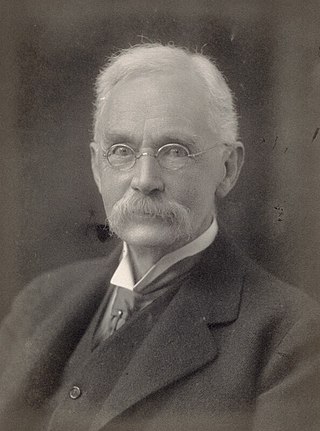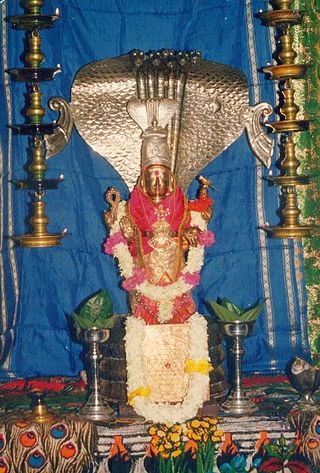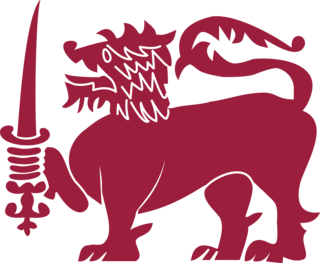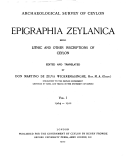
Thomas William Rhys Davids was an English scholar of the Pāli language and founder of the Pāli Text Society. He took an active part in founding the British Academy and London School for Oriental Studies.

The Rev. Archibald Henry Sayce was a pioneer British Assyriologist and linguist, who held a chair as Professor of Assyriology at the University of Oxford from 1891 to 1919. He was able to write in at least twenty ancient and modern languages, and was known for his emphasis on the importance of archaeological and monumental evidence in linguistic research. He was a contributor to articles in the 9th, 10th and 11th editions of the Encyclopædia Britannica.

Dondra is a settlement on the extreme southernmost tip of Sri Lanka, in the Indian Ocean near Matara, Southern Province, Sri Lanka. The Dondra Head Lighthouse, ruins of several Hindu shrines of Tenavaram and a Vihara are located in the vicinity.

Dakkhina Stupa is a 2nd-century BC large brick Stupa in Anuradhapura, Sri Lanka. Earlier thought to be a monument of King Elara, it was later identified as the Stupa of ancient Dakini (Dakkhina) Vihara by Senarath Paranavithana with the help of a Brahmi inscription of the 3rd century A.D. unearthed from the ground between the southern and western Vahalkadas of the Stupa.
Kayts, is one of the important villages in Velanai Island which is a small island off the coast of the Jaffna Peninsula in northern Sri Lanka. There are number of other villages within the Velanai Islands such as Allaippiddi, Mankumpan, Velanai, Saravanai, Puliyankoodal, Suruvil, Naranthanai, Karampon and Melinchimunai.

Senarath Paranavitana, was a Sri Lankan archeologist and epigraphist, who pioneered much of post-colonial archaeology in Sri Lanka. He served as the Commissioner of Archeology from 1940 to 1956 and there after as Professor of Archeology at the University of Ceylon from 1957 to 1961.

The Naga people are believed by some to be an ancient tribe who once inhabited Sri Lanka and various parts of Southern India. There are references to Nagas in several ancient texts such as Mahavamsa, Manimekalai, Mahabharata and also in other Sanskrit and Pali literature. They were generally represented as a class of super-humans taking the form of serpents who inhabit a subterranean world.

A Bandâra was a Great Officer in the Amātya Mandalaya, or Sinhalese Council of State, in the Sinhalese Kingdoms of premodern Sri Lanka. A Bandâra was the sons of a chief in the Sinhala Kingdom.
Mansel Longworth Dames (1850–1922) was a scholar of oriental and Portuguese languages.
The Basawakkulama inscription or Abhayavāpī inscription is a rock-cut record, probably from the time of king Upatissa, documenting the gift of two villages and some agricultural land to a Buddhist establishment in the late fourth century C.E. The inscription is at Anuradhapura.

Don Martino de Zilva Wickremasinghe (1865–1937) was an epigraphist and archaeologist of Sri Lanka. He studied at Richmond College, Galle. Subsequently, he worked as an assistant to H. C. P. Bell and served as the epigraphist to the Ceylon Government. He became archaeological commissioner after Bell, preceding Senarath Paranavitana in that position. His most important contribution was serving as editor and part author of the first two volumes of Epigraphia Zeylanica, a key source for the early history of Ceylon. He handed responsibility for volume 3 of Epigraphia Zeylanica to Paranavitana "...owing to reasons of health and the multifarious duties at the University of London." During his time in London, Wickremasinghe prepared a catalogue of the Sinhalese books in the library of the British Museum.
The Bodh Gayā inscription of Mahānāman is an epigraphic record documenting the construction of a temple by the Sri Lankan monk Mahānāman at Bodh Gaya in the late sixth century.

This is a bibliography of works on Sri Lanka.

Charles Otto Blagden was an English Orientalist and linguist who specialised in the Malay, Mon and Pyu languages. He is particularly known for his studies of Burmese epigraphic inscriptions in the Mon and Pyu scripts.
Girihandu Seya is an ancient Buddhist temple situated in Thiriyai, Trincomalee, Sri Lanka. The temple is supposed to be the first Buddhist Stupa in Sri Lanka, believed to be constructed by two seafaring merchants Trapusa and Bahalika. The names of the two merchants are recorded in a rock inscription found in the Vihara premises. According to the inscription, Girihandu Seya was built by the guilds of merchants named Trapassuka and Vallika where the names are written as Tapassu and Bhalluka in later Sinhala chronicles. Some scholars also hold the view that Mahayana influenced seafaring merchants from the Pallava Kingdom were responsible for the construction of this temple.
Nriputungavarman was a king of the Pallava dynasty. Nriputungavarman was the son of Nandivarman III. Nrpatungavarman had at two queens, Viramahadevi and Kadavanmadevi, as both appear in his inscriptions as donors. In his architectural contribution, the rock-cut shrine at Namakkal and a Vishnu temple built at Ukkal is made for the queen

The Lumbini pillar inscription, also called the Paderia inscription, is an inscription in the ancient Brahmi script, discovered in December 1896 on a pillar of Ashoka in Lumbini, Nepal by former Chief of the Nepalese Army General Khadga Shamsher Jang Bahadur Rana under the authority of Nepalese government and assisted by Alois Anton Führer. Another famous inscription discovered nearby in a similar context is the Nigali-Sagar inscription. The Lumbini inscription is generally categorized among the Minor Pillar Edicts of Ashoka, although it is in the past tense and in the ordinary third person, suggesting that it is not a pronouncement of Ashoka himself, but a rather later commemoration of his visit in the area.
Tamil inscriptions in Sri Lanka date from the centuries before Christ to the modern era. The vast majority of inscriptions date to the centuries following the 10th century AD, and were issued under the reigns of both Tamil and Sinhala rulers alike. Out of the Tamil rulers, almost all surviving inscriptions were issued under the occupying Chola dynasty, whilst one stone inscription and coins of the Jaffna Kingdom have also been found.

Panakaduwa copper plate is a Sri Lankan copper plate made at the request of King Vijayabahu I for a high-ranking general called Budalna. The main reason for this to be inscribed on the plate is the aid that was given by him to juvenile prince Kirthi and his family during his pre-regnal days from the Cholas. The king triumphed over the Chola ruler and victoriously led his army to mainland India. It was apparently completed around 1082-83 in the 27th year of his reign.












